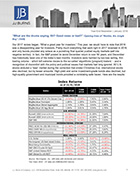“I’ve just closed my eyes again / Climbed aboard the dream weaver train / Driver take away my worries of today / And leave tomorrow behind” Gary Wright, “Dream Weaver”
Imagine if Rip Van Winkle was a 21st century investor instead of a Colonial ne’er-do-well. Imagine, too, that he fell asleep in December of 2019 and awoke on the last day of June 2021. How would he comprehend the world he’d left just 18 months earlier? As was Washington Irving’s fictional early American, he would be in a world that had experienced a contentious change of government and saw the passing of old friends and family members. If he owned stocks (as a buy-and-hold investor), he would certainly be wealthier than before his nap. The key question is, would he believe all the things that he would hear about those past 18 months with respect to the COVID pandemic, the changes in the economy and American political turmoil? Judging solely on his stock portfolio, he probably wouldn’t.
Old Rip would have benefitted from the ‘risk-on’ trade, as stocks continued their surge in the 2nd quarter. Investors across the market-cap and regional-exposure spectrum rolled with the ‘recovery’ trade and again posted solid returns for the quarter and the year-to-date. Quality taxable and municipal bonds rallied in Q2, and high-yield bonds continued to attract investors. Real estate also posted a strong quarter and is shrugging off the effects of last year’s pandemic panic.

“It’s all about the Benjamins baby” Puff Daddy. “It’s All About The Benjamins”
Shaking off eye-popping levels of cash flows into various parts of the bond market, U.S. stocks continued to grind higher on generally good news about vaccination rates and economic re-openings. The market that caught our eye, though, is Bitcoin (BTC). The digital asset had a full cycle’s returns in just six months, basically doubling in U.S. dollar price in Q1 and then sharply retreating in Q2. Hailed as the investment at the center of an effort to remake the centralized finance system we transact in today, BTC holds many promises to investors across the spectrum. It has proven to be a lucrative speculative investment over the past several years, but we don’t see it as a major portfolio holding until much of the volatility we saw in Q2 is dampened.
After doubling in the first quarter, BTC and other alternative crypto ‘coins’ attracted institutional, retail and celebrity investors who drove prices to record highs. A host of issues, including climate-change concerns, helped push speculative volatility into the crypto market. Prices have fallen considerably since early May. We can see in the graph below why this asset is not suitable for large positions in portfolios. Its short history (twelve years) also makes it difficult to reliably model. It is certainly an investment that has spurred furious debate and bears watching.
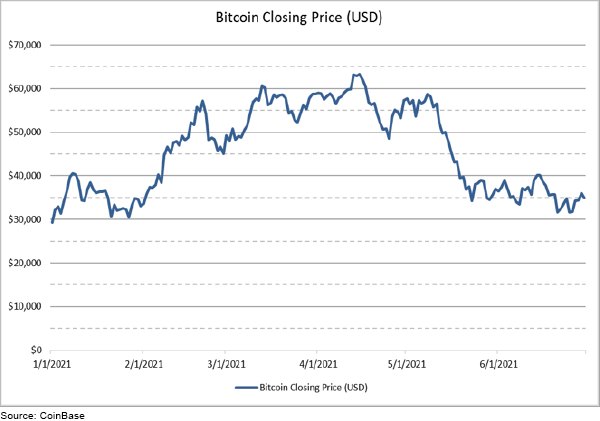
Another issue we’re following is the ‘re-opening trade,’ essentially a shift from growth stocks to value stocks as the economy enjoys a post-pandemic surge. Value-biased and smaller-cap stocks had a stellar first quarter (see large-cap data in blue below), as both are historically strong early-recovery performers. They have been beaten down in favor of the larger-cap technology trade over the past few years, and might be considered to have cheap valuations compared to growth stocks. A resurgence in the growth trade, spurred by expectations of higher economic growth and inflation going forward, pushed growth sectors to higher Q2 returns over value havens (red data).
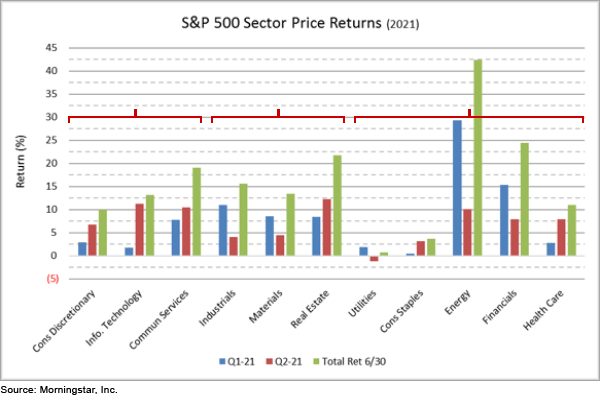
Stocks, regardless of category, are driven by earnings and valuation. Last year’s unloved sectors—financials, energy, and real estate—have rallied nicely thus far and posted strong returns in both full quarters. These three categories have compelling reasons for their rebound, yet still face challenges going forward. We think improving growth will provide them with a positive impetus. Regardless of current valuations, we still see strong economic growth ahead and recommend discrete exposure to both value and growth segments of the market. We see this theme playing out in foreign markets as well, which have more exposure to traditional value sectors and less technology exposure than U.S. markets.
“Why do we never get an answer / When we’re knocking at the door?” The Moody Blues, “Question”
The two pressing questions we see right now are, where are we in battling the coronavirus and what’s going to happen with inflation (which affects growth and interest rates)? As the Moodys sang, we don’t have answers for those questions, but we have some ideas.
This graph below represents vaccine rollout (at least one dose) in key countries. Clearly, there is a lot of work to be done in distributing and administering vaccines around the globe. Recent U.S. data indicate at least one of the U.S. vaccines provides support in combatting the Delta variant strain that is more potent than the original virus and which has ravaged India and spread to other countries. While we expect further progress in vaccinations and economic growth in developed economies, our expectations are tempered by the slow vaccine rollout and the lack of uniform preventative messaging and measures in many countries.
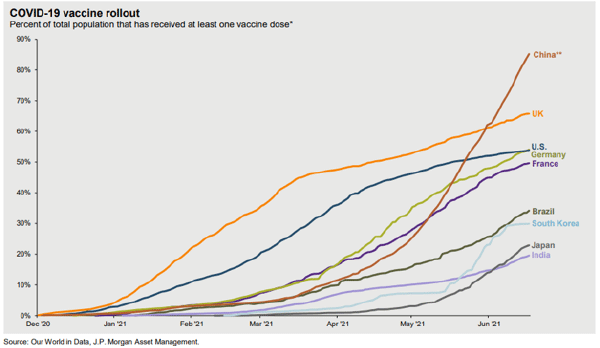
As for inflation, the first graph below indicates that, in line with history, inflation has spiked up after the recession. The issue confronting investors and policymakers is the source of inflation (prices, wages, or both), and the stickiness of each. Some current price increases are expected to be transitory (e.g. fuel), others are unknown (products with semiconductors). Costs that cannot be easily passed to consumers will result in deteriorating margins and potentially higher prices. The second graph details the recent history of inflation expectations and forecasts; notably, the 5-year forward expectations are still around 2.5%. This is a higher level than we’ve recently experienced, but far from the crippling levels of the 1970s. The Fed has indicated that they expect current elevated price levels to be transitory, which indicates lower rates for longer. Our thinking is that the pre-COVID disinflationary trends are still in place: aging boomers are retiring and cutting/shifting spending, globalization of goods and supply chains will remain in place for some time, and continued technology advancements in the workplace will displace/shift workers.
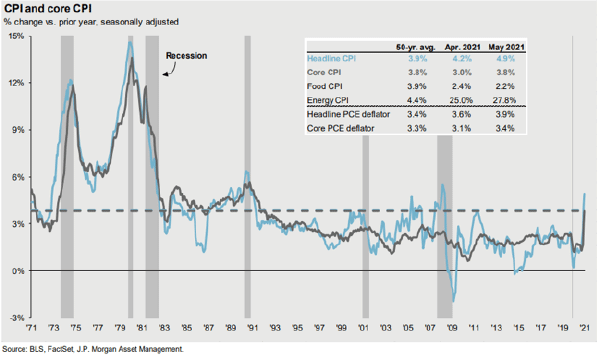
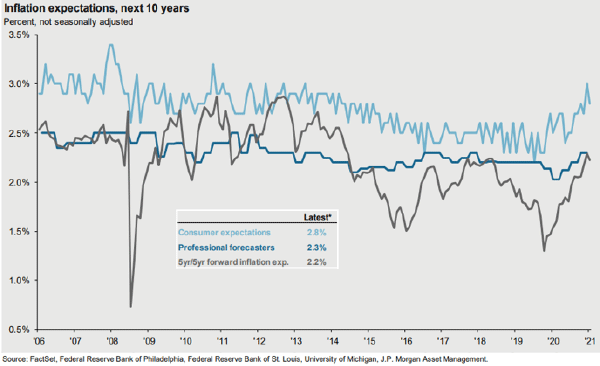
“Don’cha know, ain’t nothing like the real thing, baby / Ain’t nothing like the real thing” Marvin Gaye & Tammi Terrell, “Ain’t Nothing Like The Real Thing”
We still see a TINA (‘there is no alternative’) trade favoring equities remaining in place for some time. We also think growth will moderate next year, but there will not be a U.S. recession for some time. We do expect a market correction at some point, as the FOMO / hope trade is strong and more money may flow to stocks as yields continue to drop. Many of the cyclical recovery themes we follow also point to potentially better returns for investors in foreign stocks, which are not as technology focused as the U.S. Finally, we still expect strong growth for the next 12 to 18 months, but also see additional COVID variants and uneven vaccination regimes as challenges to global growth, as well as a market retrenchment, as concerns on the farther horizon.
As we close the books on a strong second quarter, it’s a good time to remind ourselves that investing is a marathon, not a sprint. Many of the market-moving events discussed today will be small footnotes in the future. We think about your investments over long time periods and apply proven portfolio-management principals to achieve accretive long-term results, including choosing the right asset allocation based upon your specific situation. As different segments of your portfolio grow, we rebalance your assets back to your target allocation to minimize risk. This means short-term market events do not dictate our investment policy, which in turn allows us to help clients achieve financial security in their retirement. Finally, the most important thing is to have a plan and review it often to make sure you’re on track to reach your goals.
As always, if you have any questions please feel free to contact us.
—Your Wealth Management Team at JJ Burns & Company
Download Market Commentary
Disclosure: J.J. Burns & Company, LLC is a registered investment adviser with the U.S. Securities & Exchange Commission and maintains notice filings with the States of New York, Florida Pennsylvania, New Jersey, Connecticut, Georgia, Illinois, North Carolina, and California. J.J. Burns & Company, LLC only transacts business in states where it is properly registered, or excluded or exempted from registration. Follow-up and individualized responses to persons that involves either the effecting or attempting to effect transactions in securities, or the rendering of personalized investment advice for compensation, as the case may be, will not be made absent compliance with state investment adviser and investment adviser representative registration requirements, or an applicable exemption or exclusion.
All investing involves risk, including the potential for loss of principal. There is no guarantee that any investment plan or strategy will be successful.
The foregoing content reflects the opinions of J.J. Burns & Company, LLC and is subject to change at any time without notice. Content provided herein is for informational purposes only and should not be used or construed as investment advice or a recommendation regarding the purchase or sale of any security. There is no guarantee that the statements, opinions or forecasts provided herein will prove to be correct.
Past performance may not be indicative of future results. Indices are not available for direct investment. Any investor who attempts to mimic the performance of an index would incur fees and expenses which would reduce returns.
Securities investing involves risk, including the potential for loss of principal. There is no assurance that any investment plan or strategy will be successful.


